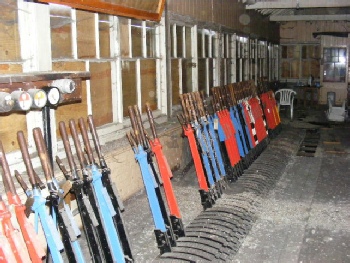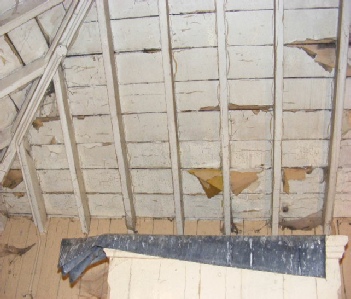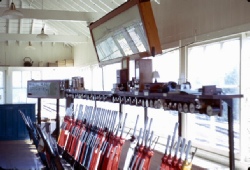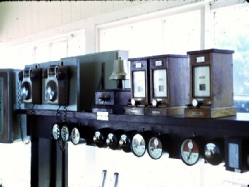The Future of the Box


The Chinnor & Princes Risborough Railway Association is a registered charity, number 1016237. It and the railway it owns are operated, managed, developed and maintained entirely by volunteers.
©PRNB 2018 Updated: 01/06/2018 E&OE

As you can read in our history pages, the box interior has been altered several times in its history. As built, the lever frame extended the full length of the structure (indeed the frame defined the size of building). The frame was replaced by a shorter one in 1958 and this was shortened again in 1968, leaving space at the South end. We propose to refit lever frame back to the original length.
Below the operating floor we want to open the interlocking room to visitors too. It will be possible to see how safety was ensured through the mechanical interlocking of the levers. There is also space for museum displays related to the history and principles of signalling, to this building in particular, and to the history of the Chinnor and Princes Risborough Railway (the former Watlington Railway) and others in the area.
The Practicalities of Restoration
Now ownership has been sorted out, funding is now being actively sought (please use the buttons on the left to see more detail on this). We will then progress as the twin resources of money and volunteer time allow. Most of the work will be done by us as volunteers, but for certain things we will have to use contractors at considerable expense: scaffolding and roof repairs for example. There will be a balance to be struck: for example if we have the money we could employ glaziers to get the window panes replaced quickly. If we don't have money but we do have plenty of volunteers, we can do it ourselves more cheaply over a much longer period. The glass alone is still likely to cost over £3000.
To date, everything has been done by a small team of volunteers from the Chinnor & Princes Risborough Railway Association. To continue the restoration and to look after the box we need to grow that team; not only people to physically work on the building, but also to run our background tasks: fund raising, campaigns & newsletters, dealing with planning and building consents, financial management etc..
The truth is we won't know how fast we can proceed until we see the results of our fund raising campaigns. These in turn depend on first finding volunteers who have the enthusiasm and skills to launch those campaigns and make them successful!
So far, we've had teams of volunteers in the box at least one day every weekend. That's the way we expect to continue, until all the work is done. More help welcome!
Apart from restoration “as was” we will probably need to install a new internal staircase at the North end of the building, to make public access easier. Such staircases were common in many similar boxes, and we can copy that style so it looks the part. We need the extra staircase because the existing fire escape ladder really isn't suitable, and not all visitors will be comfortable on the high external staircase in a gale. Such modification will require listed building consent, and will get caught up in modern building regulations. So we don't know that it will be possible to do.
Making the Building Work
The Signalman's Territory.
The focus for visitors, and therefore for us when we get to the presentation phase, will be on the operating (upper) floor. This is where all the levers and instruments go, so will be the part our clientèle will most want to see.
Generally we want to restore the box to its post 1958 working condition, and through the use of simulators enable visitors to see and feel how such a large mechanical signal box looked and was worked: the levers, the bell telegraphs, the wood-
Why 1958? The box was re-
Much remains to be done. There is more structural timberwork to be replaced or repaired, the roof needs fixing, most of the broken window panes are still broken, there is mortarwork to do, and much painting. Then there will be a modification to do to provide another entrance/exit route (see below). Just replacing all that lino will be a serious task!



The operating floor was also partitioned by British Rail in 1968, and the separated space on the South side of this was used as an office and later as a train crew mess room. Once restoration is complete, on the North side of the partition will be the rejuvenated post-
In the “museum” section, we will restore everything so far as is possible to operating condition and make it work. “Off stage”, modern technology will be used to simulate telegraph communications with adjacent signal boxes, to work indicators and other instruments, and to show the passage of trains. Many of the electrical instruments were removed at closure, but we are working to source replacements. We will probably also add other relevant artefacts to increase interest, and add explanations and features to inform visitors as to how what they see works and why it was needed.
The Lineman's Land
Downstairs was the territory of the signal and telegraph linemen who looked after the equipment. It houses the base of the lever frame with all its interlocking. We aim to open the ground floor to the public, so they can see the kit in action. There is space along the back wall for further museum displays etc. We want to make the best use of this area possible, but the detail is still some way off. The part of the locking room beneath the operational end of the signal box will not be open to visitors as it will contain equipment pertinent to the safety of the active railway. It will look similar to the rest of the locking room as more of the same kit will be used, so this is no great hardship.
There is an intermediate level in this building, but its ladder-
It will take many years to achieve all of the above, but hopefully it gives an idea of our target!
Then, for the first time, we will be able to routinely open the building up to visitors to the Chinnor & Princes Risborough Railway so they can see inside. But really only the first phase of our works will have been completed.
The Eventual Aims
We want to restore the building and equipment to function as a working signal box to control the trains of the CPRR when its line is extended into Princes Risborough station. However this only requires a small part of the building, as our track layout will be very simple compared to the main line station and rail traffic the box was built to serve. This provides us with the opportunity to open up the rest of the building as a museum and visitor attraction.
Our Aims
We want to restore the building and get the signalling equipment working, and then both use it operationally to control trains on the Chinnor & Princes Risborough Railway and open it to visitors as an example of our railway heritage.
Ownership and Funding
The restoration and development of Princes Risborough North Box is intertwined with the extension of the Chinnor & Princes Risborough Railway into the station. In 2017, negotiations have been successfully concluded between CPRR and NR to lease the relevant land for this extension, and this land includes the North Box.
Now we have security of tenure for the box, a challenge is resolving how major works on the signal box can be funded. In 2011 we started an appeal for funds and since then several fund-
We need to step up our activities in this area. Along with looking for more volunteers to help with the physical restoration of the building, we're looking for help with the administrative side: applying for grant funding, presentations and exhibitions, planning applications etc..
The intention is that as well as using the Princes Risborough North signal box operationally, to control the new track layout of the Chinnor & Princes Risborough Railway outside, we will restore the building and open part of it to visitors. With the equipment returned to working order, it will be possible to demonstrate how traditional mechanical signalling and telegraph systems used to operate. Achievement of this will require some modest change to the building, and we are preparing to submit an application for Listed Building Consent. The changes are necessary to permit adequate entry and exit routes for visitors.
Restoration
The first priority has to be to halt the deterioration of the building. As you can read on our history pages, time has not been kind and the ongoing threats of weather, vibration, vandals and pigeons all have to be combated. Again our history pages show what we have already been able to do. With deterioration controlled, we can move on to repairing the damage already done.
| Working Life |
| The Wilderness Years |
| Recent history until Nov 2013 |
| Recent works 2 |
| Recent History (from 2014) |
| CPRRA Years (2017/18) |
| Reconnection (2018/19) |
| Mouldsworth |
| Discovery |
| Rescue |
| Restoration |